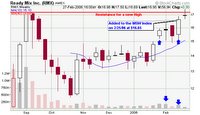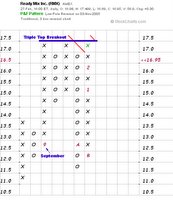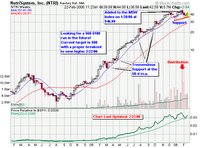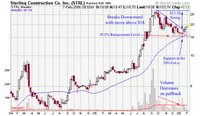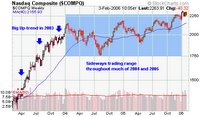Below is an excellent article on a topic I have been covering and teaching for years. At the end of the article, the author mentions Tharp’s book
Trade Your Way to Financial Freedom and I recommend the book to anyone that is interested in position sizing and expectancy. I have developed a portion of my position sizing formula from this book. I don’t buy into everything in the book but there are a few very important chapters.
Sound Money Management Key in TradingBY LOREN FLECKENSTEIN
INVESTOR'S BUSINESS DAILY
This story was originally published February 19, 1999
For more information, please see www.investors.comA few years ago, forty people with doctorate degrees took part in a revealing experiment in money management.
Ralph Vince, an expert on the mathematics of trading, asked each participant to play 100 rounds of a computerized betting game. Each player started with $ 1,000 in play money and the freedom to vary the size of each wager. The odds favored players 60% of time.
At the end of the experiment, 38 of Vince's 40 highly educated guinea pigs had lost money. That performance illustrates a key to successful trading. Sound money management is just as important as being right on any given trade.
In the Vince experiment, the players won 60% of the games, but they still lost money. Why? They knew nothing about proper position sizing. So they made outsized bets that overexposed their bankrolls. They also fell prey to gambler's fallacy, an instinctive but deadly tendency to raise bets during losing streaks and lower bets during winning streaks.
People go broke making the same mistakes in the securities markets. With sound money management, you can avoid these pitfalls. And you can build considerable wealth while facing far worse trading odds than the 60% player advantage in Vince's computer game.
Most traders are wrong more than 50% of the time. And that's fine, said Vic Sperandeo, a Dallas-based options trader. Successful traders can be right on 35% of their trades and make killings. The name of the game is to cut your losses short and let your profits run.
A basic performance ratio proves the point. Let's say a trader loses money on 65% of his trades. But he follows an ironclad stop-loss rule. He sells any stock that falls 8% below his cost.
Meanwhile, he picks winners only 35% of the time. But he holds those stocks long enough to offset his losses and then some. On average, he sells his winners for a 32% gain.
Thanks to that discipline of cutting losses short and letting profits run, the trader makes twice as much money as he loses, even though most of his stock picks end in small losses.
Money management is even more critical in options and futures trading. Derivatives impose far greater price volatility than equities. So options and futures traders have short trading lives without strong money management. They also face unique time constraints.
Because futures contracts expire, futures traders know they must exit even a good trade at some point, said Cynthia Kase, president of Kase & Co., an Albuquerque, N.M.-based adviser on hedging and trading strategies. Equity traders don't have to exit a trade. They tend to be much more focused on getting into a trade than how to get out at a profit.
For many retail stock traders, loss cutting is perhaps the best-known part of money management. Many growth- stock investors use an 8% stop-loss rule. They sell if a stock falls 8% below its purchase price.
But money management can begin before you buy a security. It starts with position sizing. That means limiting the size of what you are prepared to lose in any single trade to a percentage of your total trading capital.
Why? There is always the risk that a position will tank before you can execute your stop-loss rule. For example, a stock can gap down at the open because of negative overnight news.
Such an event is more likely than you might suspect. Say the odds are only 1 in 100, or 1%. The more you trade, the more likely that event will occur. The probability of that event occurring over the course of 50 trades is 50%.
Sperandeo says that most successful traders rarely risk more than 2% of capital in a single trade. Many pros set the bar as low as 1%.
Take a 100,000 trading account. If the account holder sets the maximum loss per trade at 1% of total capital, he would cover any losing position before the account drawdown exceeds $ 1,000.
What if you also use price-based sell rules? No problem. With a little arithmetic, you can calculate a position size that satisfies both your sell rule and your maximum drawdown.
Let's say the above-mentioned trader wants to sell any stock that falls 8% below his purchase price? The maximum size of his position would be $ 12,500.
Kase uses position size to control portfolio risk. This allows her to adjust her stop-loss to reflect the market risk or volatility unique to each traded security.
The risk in the market is not what we want it to be, Kase said. The risk is what the market imposes upon us.
When Kase looks at trading a stock, option or commodity, she sets her trade's stop-loss just outside her calculation of that security's noise, random price movement produced by the security's typical volatility. The largest dollar amount that Kase will risk per trade is decided by her risk of ruin formula. More mathematically inclined investors may find it useful. For a full treatment, see Kase's book, Trading with the Odds.
Position sizing has another valuable benefit. It improves on gains during winning streaks. It curtails losses during losing streaks. During winning streaks, your capital grows, which slowly leads to larger position sizes. During losing streaks, position size shrinks with your account, leading to smaller losses.
Many people lose a bundle doing the exact opposite. They take bigger positions after losing trades and incur bigger losses. When they win, they shrink the size of their trades, crimping their gains.
Such behavior stems from gambler's fallacy, according to Van Tharp, a research psychologist who has studied the trading systems and habits of thousands of traders. He defines gambler's fallacy as the belief that a loss is due after a string of winners and/or that a gain is due after a string of losers.
Emotions and instincts drive much human behavior, but can lead to disastrous financial decisions. Tharp devotes part of his new book, Trade Your Way To Financial Freedom (McGraw- Hill 1998), to natural biases and behaviors that can harm trading performance.

